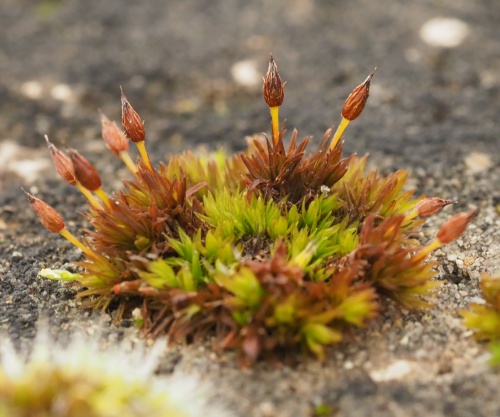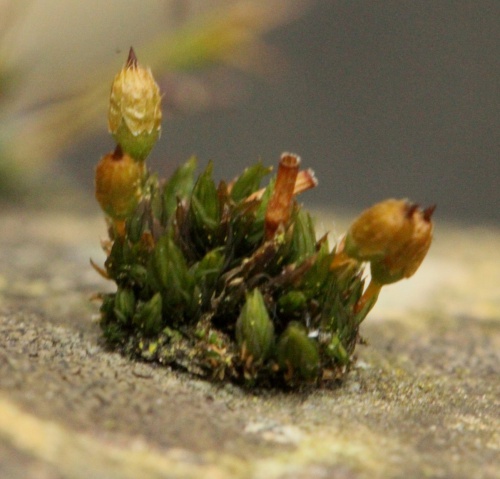Anomalous Bristle-moss - Orthotrichum anomalum
O. anomalum differs from most British members of the genus in growing on rocks or masonry rather than trees. The dark reddish-brown ripe capsules of O. anomalum are held well above low cushions of straight-leaved, green or brown shoots on a 2 to 4 mm long seta: a distinctive appearance not shared by other common mosses of the lowlands, except Ulota species that grow on trees and shrubs. Each capsule has 16 erect outer peristome teeth and strong ribs when it is dry. Mature capsules are reddish-brown, but light green when unripe. The calyptra is light brown and is
sparsely hairy. Shoots are typically about 1.5 cm tall, with leaves 2.5 to 4 mm long, and capsules about 2 mm long.
More or less ubiquitous on concrete, gravestones, wall tops and other man made structures except in the most polluted parts of Britain. Also common on exposed limestone, but absent from chalk. It is not found on acidic rock. O. anomalum occasionally grows on trees and shrubs.
Widespread and common in Britain.
Frequent in Leicestershire and Rutland.
Leicestershire & Rutland Map
Enter a town or village to see local records
MAP KEY:
Yellow squares = NBN records (all known data)
Coloured circles = NatureSpot records: 2020+ | 2015-2019 | pre-2015
UK Map
Species profile
- Common names
- Anomalous Bristle-moss
- Species group:
- Mosses & Liverworts
- Kingdom:
- Plantae
- Order:
- Orthotrichales
- Family:
- Orthotrichaceae
- Records on NatureSpot:
- 60
- First record:
- 14/01/2012 (Nicholls, David)
- Last record:
- 03/03/2024 (Smith, Peter)
Total records by month
% of records within its species group
10km squares with records
The latest images and records displayed below include those awaiting verification checks so we cannot guarantee that every identification is correct. Once accepted, the record displays a green tick.
In the Latest Records section, click on the header to sort A-Z, and again to sort Z-A. Use the header boxes to filter the list.


















